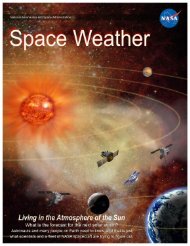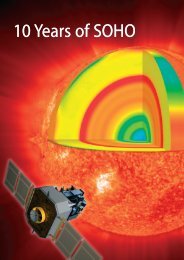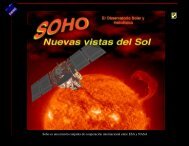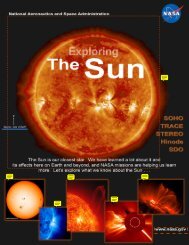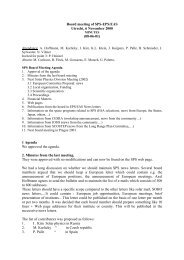Four years of SOHO Discoveries-Some Highlights - Nasa
Four years of SOHO Discoveries-Some Highlights - Nasa
Four years of SOHO Discoveries-Some Highlights - Nasa
- No tags were found...
You also want an ePaper? Increase the reach of your titles
YUMPU automatically turns print PDFs into web optimized ePapers that Google loves.
ulletin 102 — may 2000 bullTable 1. The <strong>SOHO</strong> scientific instrumentsInvestigationPrincipal InvestigatorGOLF Global Oscillations at Low Frequencies A. Gabriel, IAS, Orsay, FranceVIRGO Variability <strong>of</strong> Solar Irradiance and Gravity Oscillations C. Fröhlich, PMOD Davos, SwitzerlandMDI Michelson Doppler Imager P. Scherrer, Stanford University, USASUMER Solar Ultraviolet Measurements <strong>of</strong> Emitted Radiation K. Wilhelm, MPAe Lindau, GermanyCDS Coronal Diagnostic Spectrometer R. Harrison, RAL, Chilton, UKEIT Extreme-Ultraviolet Imaging Telescope J.-P. Delaboudinière, IAS, Orsay, FranceUVCS Ultra-Violet Coronagraph Spectrometer J. Kohl, SAO, Cambridge, USALASCO Large-Angle Spectroscopic Coronagraph R. Howard, NRL, Washington, USASWAN Solar Wind Anisotropies J.-L. Bertaux, SA, Verrières, FranceCELIAS Charge, Element and Isotope Analysis System P. Bochsler, Univ. <strong>of</strong> Bern, SwitzerlandCOSTEP Comprehensive Supra-Thermal and Energetic-Particle Analyser H. Kunow, Univ. <strong>of</strong> Kiel, GermanyERNE Energetic and Relativistic Nuclei and Electron Experiment J. Torsti, Univ. <strong>of</strong> Turku, FinlandIAS : Institut d’Astrophysique Spatiale SAO : Smithsonian Astrophysical ObservatoryPMOD : Physikalisch-Meteorologisches Observatorium Davos NRL : Naval Research LaboratoryRAL : Rutherford Appleton Laboratory SA : Service d’AeronomieMPAe: Max-Planck-Institut für Aeronomiecan infer the temperature, density, elementaland isotopic abundances, interior mixing,interior rotation and flows, even the age <strong>of</strong> theSolar System, and pursue such esotericmatters as testing the constancy <strong>of</strong> thegravitational constant.Interior rotation and flowsThe nearly uninterrupted data from <strong>SOHO</strong>’sMichelson Doppler Imager (MDI) yield oscillationpower spectra with an unprecedented signalto-noiseratio that allow the determination <strong>of</strong>the frequency splittings <strong>of</strong> the global resonantacoustic modes <strong>of</strong> the Sun with exceptionalaccuracy. These data confirm that the decreasein angular velocity Ω with latitude seen at thesurface extends with little radial variationthrough much <strong>of</strong> the convection zone, at thebase <strong>of</strong> which is an adjustment layer, called the‘tachocline’, leading to nearly uniform rotationdeeper in the radiative interior (Fig. 1).Furthermore, a prominent rotational shearinglayer in which Ω increases just below the surfaceis discernible at low- to mid-latitudes.The MDI team has also been able to study thesolar rotation closer to the poles than has beenachieved in previous investigations. The datahave revealed that the angular velocity isdistinctly lower at high latitudes than previouslyextrapolated from measurements at lowerlatitudes based on surface Doppler observationsand helioseismology. Moreover, they foundevidence <strong>of</strong> a submerged polar jet nearlatitudes <strong>of</strong> 75°, which is rotating more rapidlythan its immediate surroundings (red oval nearthe poles in Fig. 2).Alternating zonal bands <strong>of</strong> faster and slowerrotation (± 7 m/s) at a depth <strong>of</strong> 2 – 9 Mmappear to coincide with an evolving pattern <strong>of</strong>‘torsional oscillations’ reported from earliersurface Doppler studies (Fig. 2). Clear evidence<strong>of</strong> the migration <strong>of</strong> these zonal flows towardsthe equator has been found, and a recentstudy has established that these banded flowsare not merely a near-surface phenomenon.Rather, they extend downward at least 60 Mm(some 8% <strong>of</strong> the total solar radius) and thusare evident over a significant fraction <strong>of</strong> thenearly 200 Mm depth <strong>of</strong> the solar convectionzone (Fig. 3).Long-lived velocity cells extending over 40–50°<strong>of</strong> longitude, but less than 10° <strong>of</strong> latitude, havebeen identified with the elusive ‘giant cells’ byBeck et al.. Their suprisingly large aspect ratiomay be a consequence <strong>of</strong> the Sun’s differentialrotation, whereby larger features are broken upby rotational shear.High-precision MDI measurements <strong>of</strong> the Sun’sshape obtained during two special 360° rollmanoeuvres <strong>of</strong> the <strong>SOHO</strong> spacecraft have70



